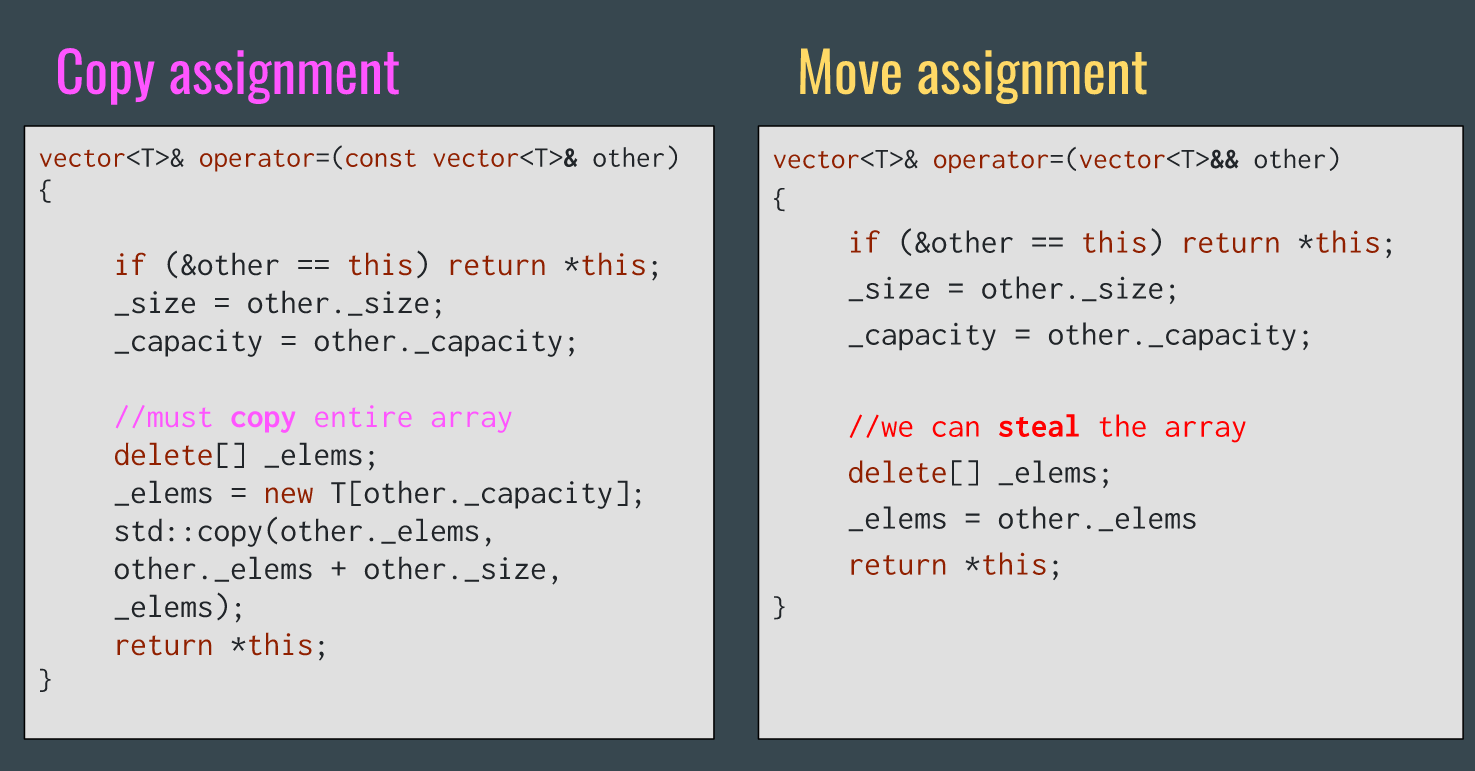CS106L: Class
CS106L 中关于类的部分
Class
A struct simply feels like an open pile of bits with very little in the way of encapsulation or functionality. A class feels like a living and responsible member of society with intelligent services, a strong encapsulation barrier, and a well defined interface
- Bjarne Stroustrup
构造函数初始化列表
Student(std::string name, std::string state, int age):
name(name), state(state), age(age){ }函数体内部还是可以写代码的
关于 delete
array 作为一个基础的类型,当开发者手动为此创建内存之后也可以之后手动释放掉:
//int * is the type of an array variable
int *my_int_array;
//this is how you initialize an array
my_int_array = new int[10];
//this is how you index into an array
int one_element = my_int_array[0];
delete [] my_int_array;delete 一般在类的析构函数中出现(需要手动掉释放这块内存)
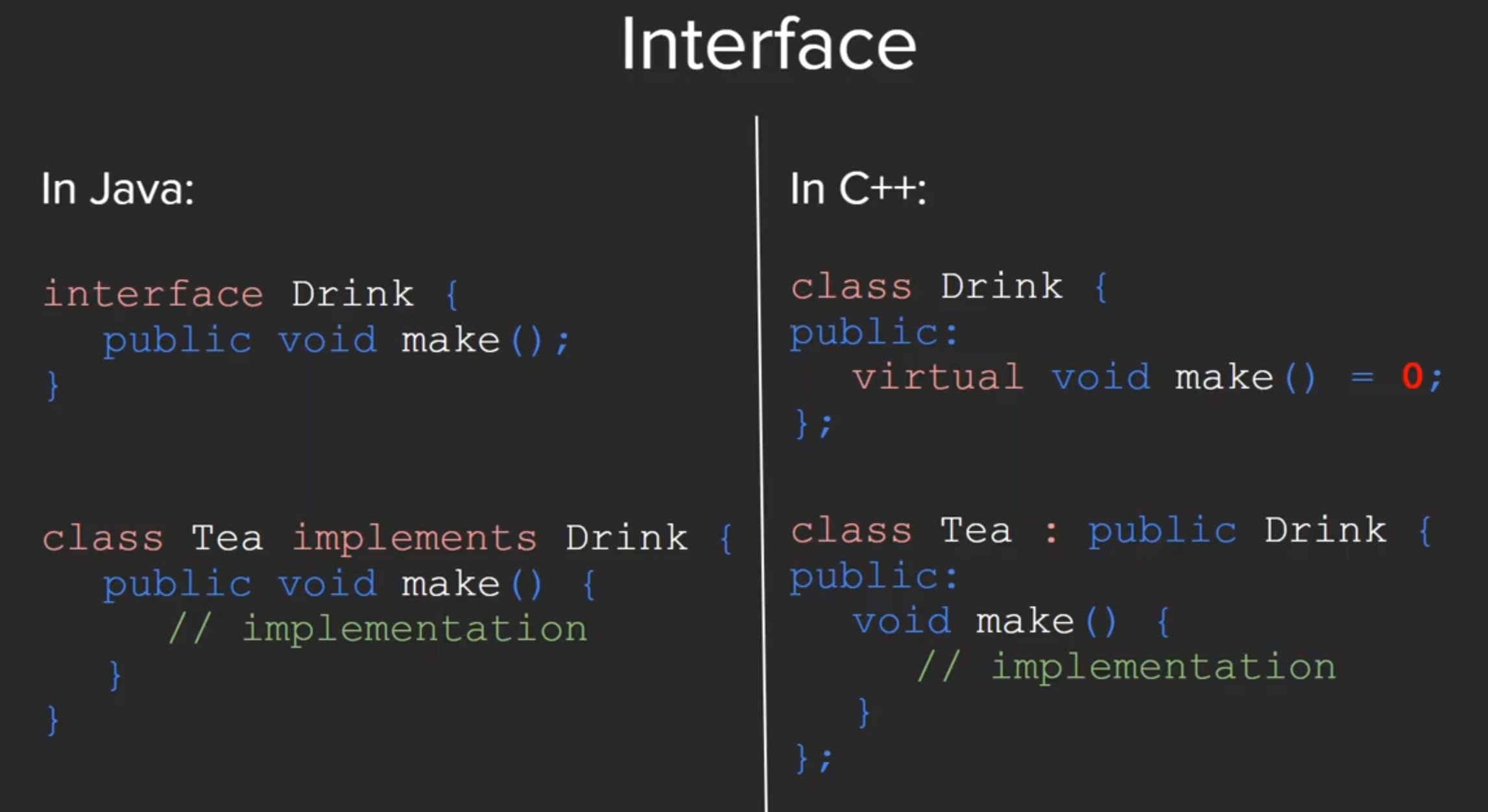
这里那个虚函数等于 0 的意义在于,让继承它的类必须实现该函数,否则编译失败。这种虚函数叫作纯虚函数(pure virtual function
一个类存在一个纯虚函数就叫作抽象类,抽象类不能被实例化。
如何子类不想要实现自己的构造函数,可以:

如果是析构函数可能有点麻烦,如果有一个基类(这个类的析构函数不是虚函数)的指针指向派生类,并且这时候要 delete 这个指针就不会调用派生类的析构函数。如果基类的析构函数实现为虚函数,那么才可以正常调用派生类的析构函数释放内存。


如果基类的虚函数有实现了,并且派生类想要调用,可以这么写:
t.Drink::make();Template classes
Fundamental Theorem of Software Engineering: Any problem can be solved by adding enough layers of indirection
模板类之前也见到过:std::vector<int>。
//Example: Structs
template<typename First, typename Second> struct MyPair {
First first;
Second second;
};
template<typename First, typename Second> class MyPair {
public:
First getFirst();
Second getSecond();
void setFirst(First f);
void setSecond(Second f);
private:
First first;
Second second;
};
template<class First, class Second> class MyPair {
public:
/*...*/
private:
First first;
Second second;
};而其部分函数的实现,也需要加 template:
template<typename First, typename Second>
First MyPair::getFirst(){
return first;
}模板类的成员函数和其他函数并不一样,编写的时候最好在一起,而不是像其他普通的编写一样,分为.h 和.cpp 两个文件。因为模板类的成员函数需要编译时的实例化,需要具体的参数生成对应函数的实现。
模板类可以针对特定类型写一个版本:
template<>
class FooSpecial<float> {
public:
FooSpecial(float var) : var_(var) {}
void print() {
std::cout << "hello float! " << var_ << std::endl;
}
private:
float var_;
};const keyword
const 函数不可以修改类的元素后者传给它的参数。
int * const p;(*p)++ // ok
p++ // error
const-interface:所有成员函数都可以在定义类的时候被 const 标记
class StrVector {
public:
using iterator = std::string*;
const size_t kInitialSize = 2;
/*...*/
size_t size() const; //here
bool empty() const; //here
std::string& at(size_t indx);
void insert(size_t pos, const std::string& elem);
void push_back(const std::string& elem);
iterator begin();
iterator end();
/*...*/这种标记是一种 const 成员函数,它保证了函数内部不会修改 this 实例。
Operators
运算符重载
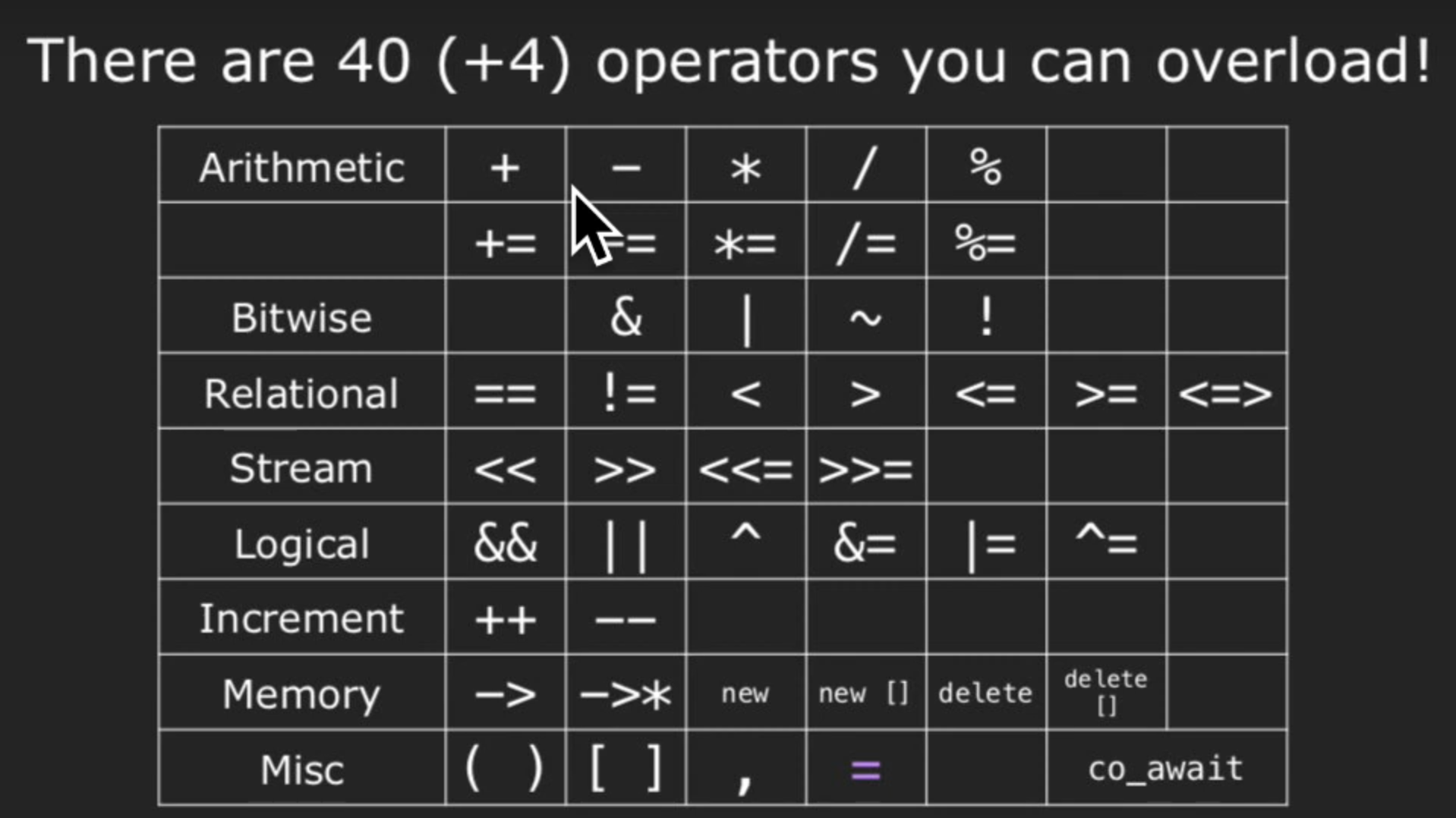
std::vector<std::string> strvec{"Hello", "World"};
std::cout << strvec[0];
strvec[1] += "!";上面这段代码相当于:
std::vector<std::string> strvec{"Hello", "World"};
std::cout.operator<<(strvec.operator[](0));
strvec.operator[](1).operator+=("!");或者是这样:
std::vector<std::string> strvec{"Hello", "World"};
operator<<(std::cout, strvec.operator[](0));
operator+=(strvec.operator[](1), "!");每个运算符都有一个与之对应的函数
对于操作符重载时的返回值问题,有的虽然看起来不会有返回值其实也是有的,例如 i += z,返回值就应该是 i,所以 (i += z) += y 这样的操作也是可以的。
像 += 这种都是类自己的成员函数,会被这个类型的变量所调用,所以对这种运算符重载,参数表只有一个参数,通过 *this 还是可以访问到那个变量。
假设实现 + 运算符的重载:
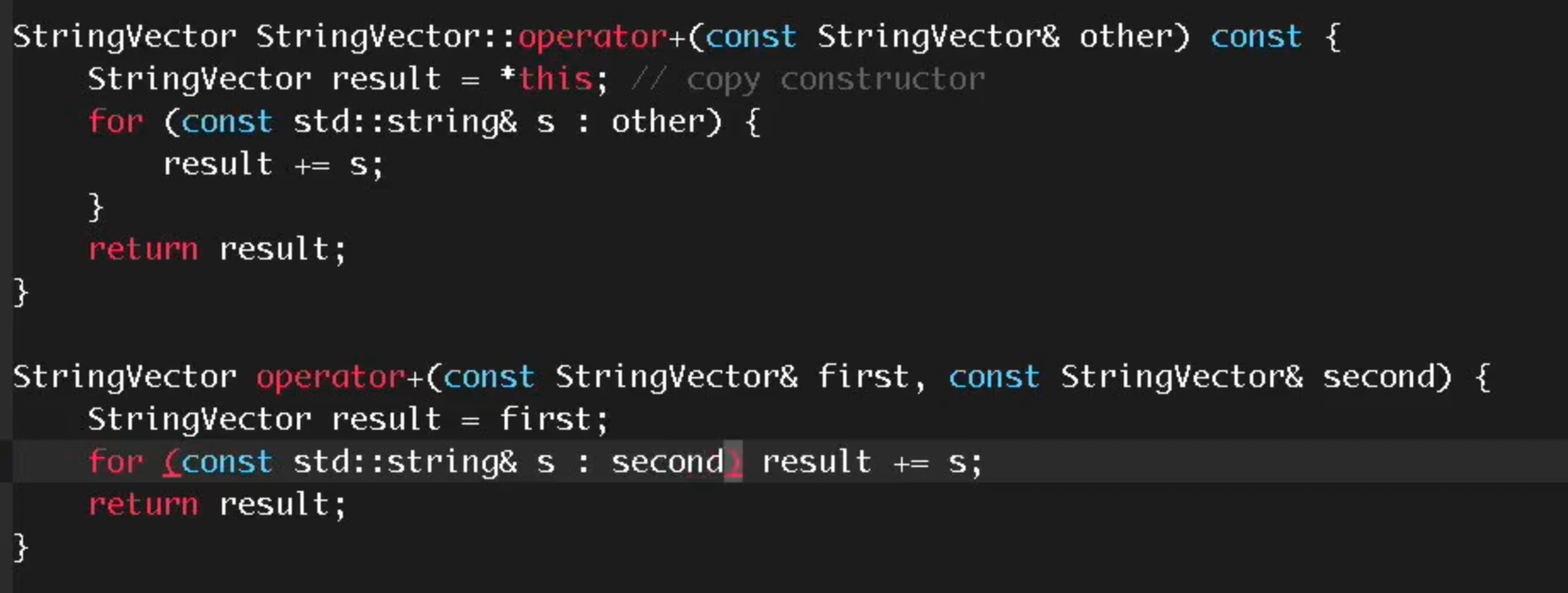
将重载的函数实现成成员函数还是非成员函数的一般规则:
- 由于 C++的语义原因,一些操作符必须被实现为成员函数(例如
[],(),->,=) - 还有一些必须实现为非成员函数(例如
<<,开发者不能覆盖掉 STL 库的实现,所以需要实现为非成员函数) - 如果是一元操作符(例如
++)就实现为成员函数。 - 如果是二元操作符,而且对这两个变量的操作是一致的(即要么都修改,要么都不修改),就实现成非成员函数(例如
+,<)。 - 如果是二元操作符,但是对这两个变量的操作不一致,就实现为成员函数(例如
+=)。
如果非成员函数涉及到访问类的私有变量,可以考虑 friends
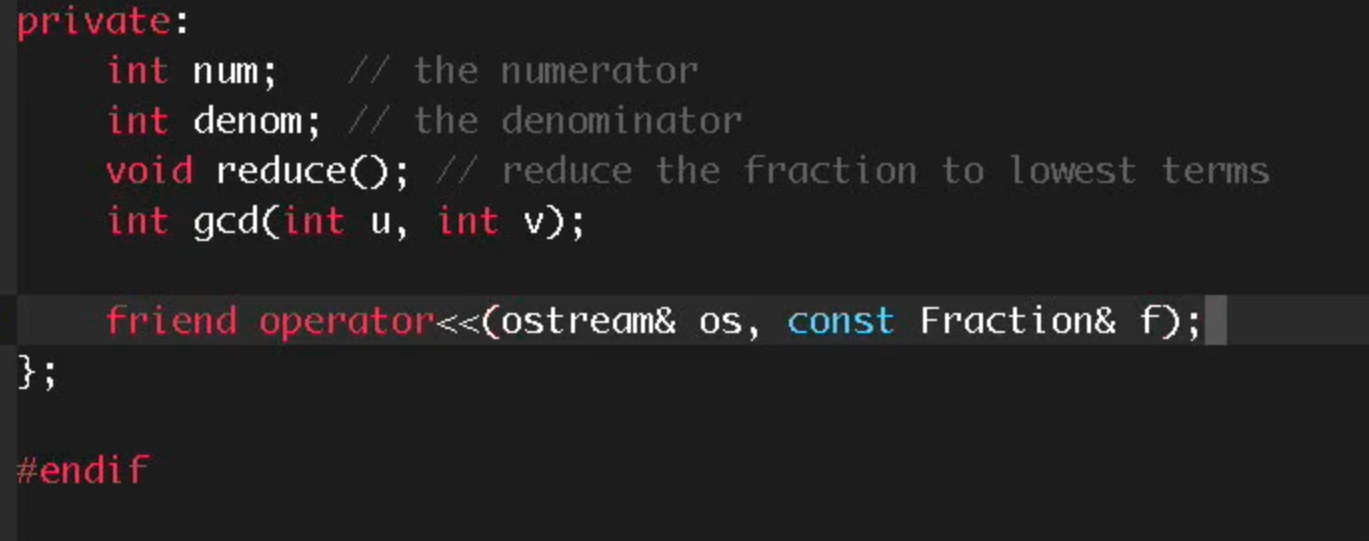
Principle of Least Astonishment (POLA)
- 设计一个操作符主要是为了模仿传统意义上该操作符的用法
- 比如之前提到的
+=需要有一个返回值
- 比如之前提到的
- 对称的运算符需要实现为非成员函数
- 这里说的对称的意思感觉就是运算符两边的表达式可以互换,举的例子是
a + 1这样的,如果是成员函数的话1 + a就不能调用对应函数了。
- 这里说的对称的意思感觉就是运算符两边的表达式可以互换,举的例子是
- 如果重载了一个运算符,它相关那一套都需要重载。
- 这里的一套就是上面介绍有哪些运算符中那个分类,一套说的是那里面的一类。
Special Member Functions
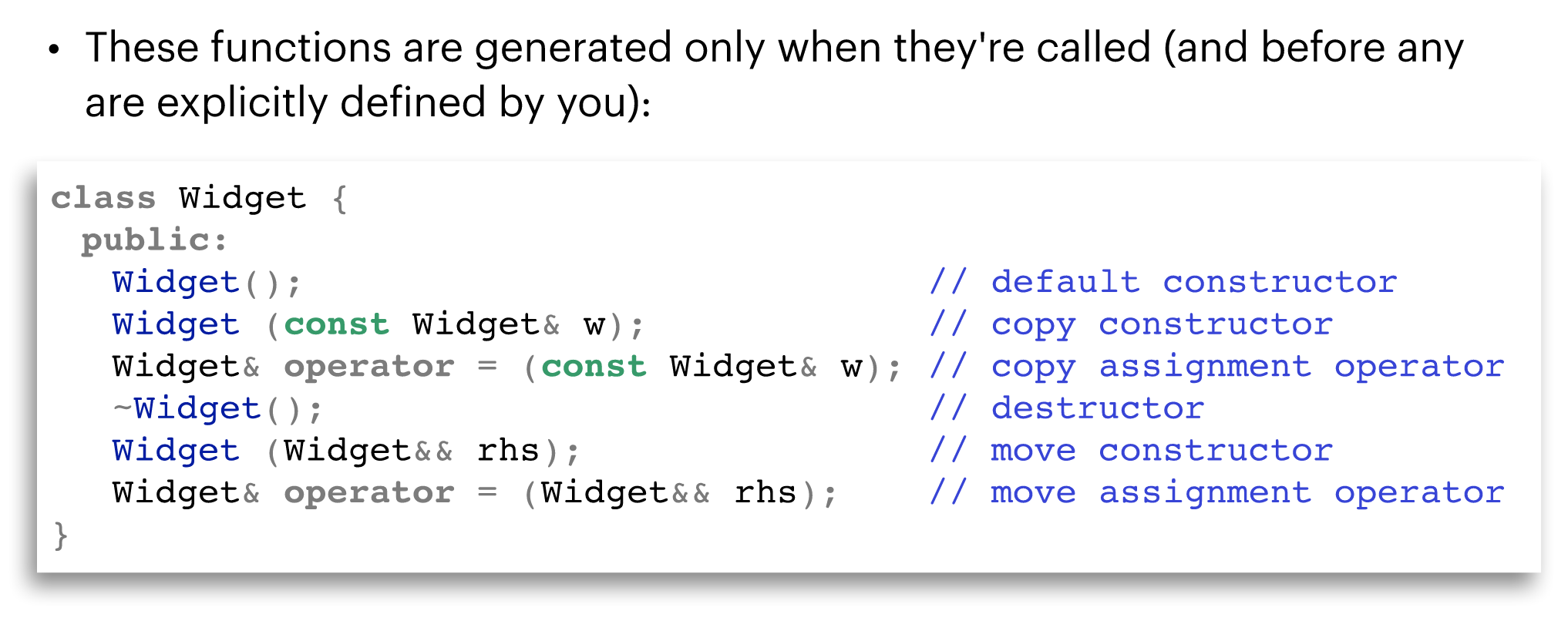
它们特殊在如果开发者不自己实现的话,编译器会自动生成,但是编译器自动生成的有时候未必能满足开发者的需要。
这些函数就是:构造函数,析构函数,复制构造函数,复制运算符。其中,复制构造函数会创建一个新的变量(也是在创建新变量的时候被调用的)。
Copy Semantics
编译器默认生成的复制构造函数会把很多信息都复制一遍,所以新变量和旧变量的指针会指向同一个内存,复制运算符会把要覆写的变量清空然后重新全部复制一遍。
Student(const Student& other) noexcept:
name(other.name), state(other.state), age(other.age){
//body
}重载复制运算符的时候就不能像上面这样写初始化列表了,毕竟它不是构造函数(
当这个类有一些自己独有的资源时(比如指针,文件流),应该写自己的复制构造函数。
当要实现(删除)一个复制构造函数或者复制运算符或者析构函数的时候,你应该实现(删除)这三个所有。
Move Semantics
移动语义代表了 C++ 的一大哲学——尽量不要牺牲效率。
例如 std::vector 中有一个与 push_back() 类似的函数:emplace_back()。它和 push_back() 不同的是,它可以将参数在内部直接构造插入,而不是像 push_back() 需要创建一个已有的变量。cppreference 网站关于它的条目中 有一个例子:
#include <vector>
#include <cassert>
#include <iostream>
#include <string>
struct President
{
std::string name;
std::string country;
int year;
President(std::string p_name, std::string p_country, int p_year)
: name(std::move(p_name)), country(std::move(p_country)), year(p_year)
{
std::cout << "I am being constructed.\n";
}
President(President&& other)
: name(std::move(other.name)), country(std::move(other.country)), year(other.year)
{
std::cout << "I am being moved.\n";
}
President& operator=(const President& other) = default;
};
int main()
{
std::vector<President> elections;
std::cout << "emplace_back:\n";
auto& ref = elections.emplace_back("Nelson Mandela", "South Africa", 1994);
assert(ref.year == 1994 && "uses a reference to the created object (C++17)");
std::vector<President> reElections;
std::cout << "\npush_back:\n";
reElections.push_back(President("Franklin Delano Roosevelt", "the USA", 1936));
std::cout << "\nContents:\n";
for (President const& president: elections)
std::cout << president.name << " was elected president of "
<< president.country << " in " << president.year << ".\n";
for (President const& president: reElections)
std::cout << president.name << " was re-elected president of "
<< president.country << " in " << president.year << ".\n";
}可以看到:
auto& ref = elections.emplace_back("Nelson Mandela", "South Africa", 1994);
reElections.push_back(President("Franklin Delano Roosevelt", "the USA", 1936));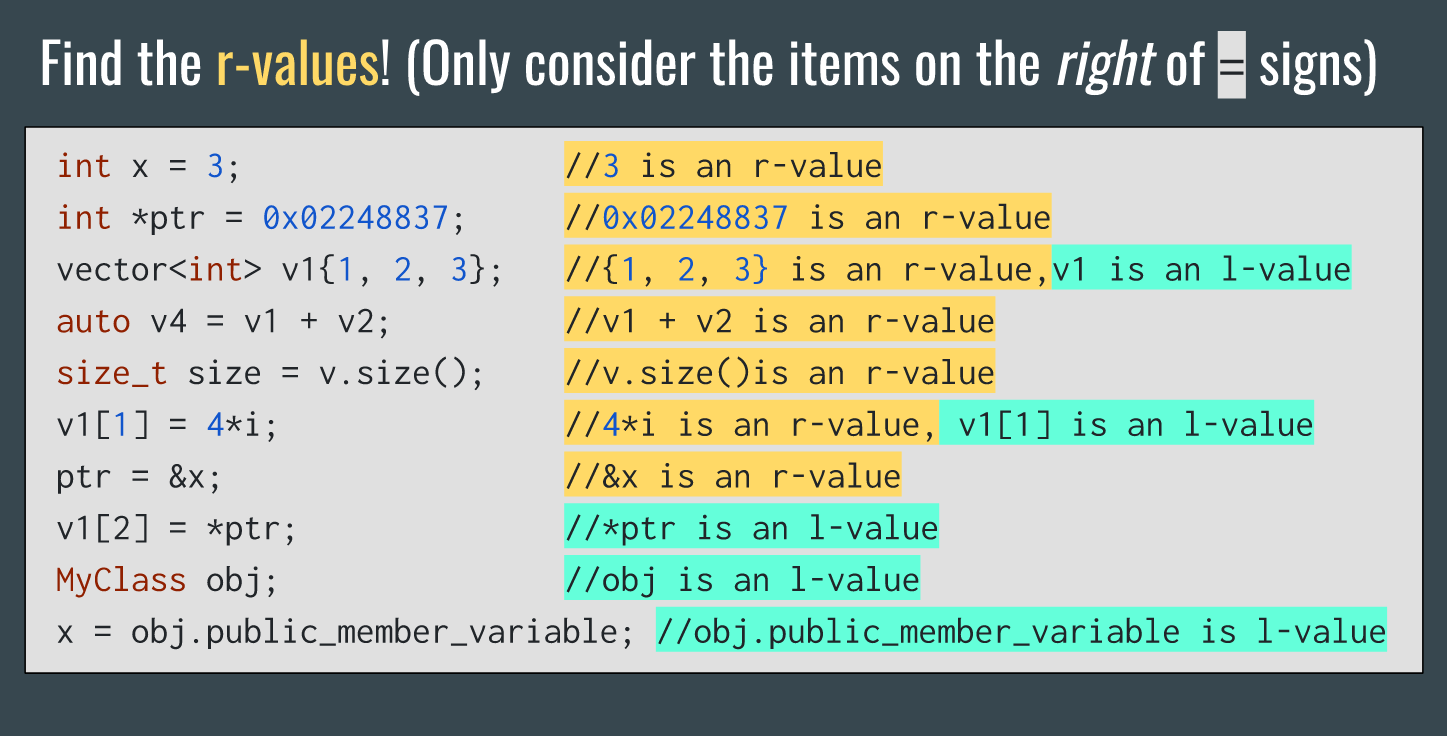
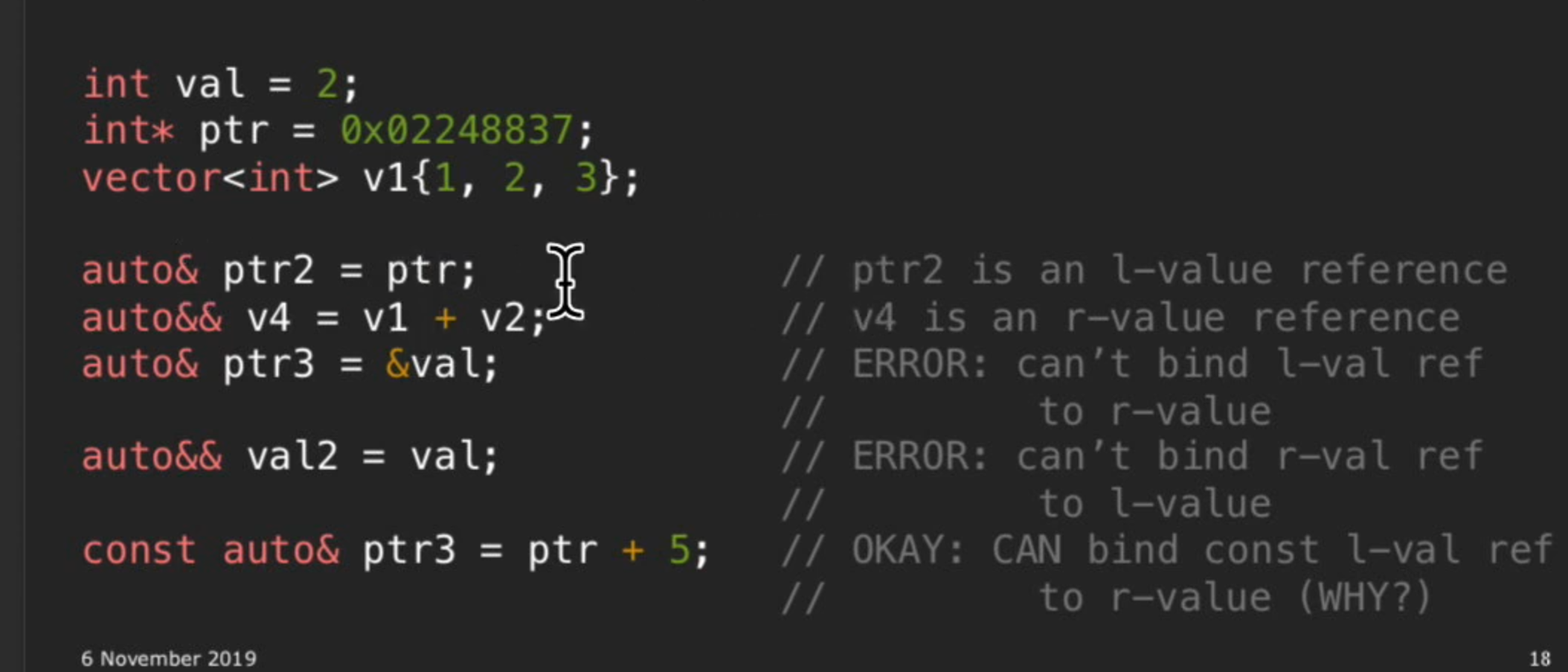
移动构造函数和移动符号的函数原型如下:
Student(Student&& other) noexcept;
Student& operator=(Student&& rhs) noexcept;但是虽然参数列表里面写的是 && 右值引用,但是在函数体内部,这个引用本身是一个左值,常规的 = 不再是移动而是复制。为了让复制变成移动,需要用到 std::move(),它会接受一个左值并返回相应的右值。经验之谈:在类成员函数中,如果接受一个 const & 参数并在函数内部将其赋值给其他变量,那么通常可以使用 std::move,除此之外不要使用它。
如果一个类定义了复制构造函数和复制运算符,那么应该也实现一份移动构造函数和移动运算符。
